GERMANS SET TO SNUFF OUT BASTOGNE GARRISON
Bastogne, Eastern Belgium • January 3, 1945
Beginning on this date and the next in January 1945 the German Wehrmacht (armed forces) began a risky, last-ditch attack on the U.S. garrison at Bastogne in Eastern Belgium. Adolf Hitler, in planning his massive onslaught against Anglo-American forces via the densely forested Ardennes region shared by Belgium, France, and Luxembourg (Operation Watch on the Rhine), recognized Bastogne’s importance. Not only was the small village (population less than 4,000) a communication hub—one of three in the Ardennes—from which seven major hard-surfaced roads emanated from its town square, but an enemy-held Bastogne could hinder the Wehrmacht’s thrust to the Belgian coast and constitute a danger to the German flank.
General der Panzertruppe Baron Hasso von Manteuffel, commander of the 5th Panzer Army, was determined as ever to “erase” the American garrison at Bastogne, calling it the “central problem” now that the German Ardennes Campaign, better known in the West as “The Battle of the Bulge,” had sputtered out in early January 1945. Just days before, more than 100,000 men of the 5th Panzer Army were assembling in the Bastogne sector, ready to converge on the town (another 30,000 were en route) and strike a victory or at least chew up American divisions that poured into the fight. Though armored spearheads of Gen. George S. Patton’s U.S. Third Army managed late on December 26 to relieve Manteuffel’s siege of Bastogne (December 20–27, 1944), Patton, following a visit there on New Year’s Day 1945, confided in his diary on January 4 after a letup in fighting around Bastogne that day and the previous one: “We can still lose this war . . . the Germans are colder and hungrier than we are, but they fight better.”
However it was the Germans who lost the war in the West (and with it, Bastogne) when, on January 16, 1945, Patton’s Third Army at last met up with Gen. Courtney Hodges’ U.S. First Army at Houffalize, now a moonscape of charred rubble less than 20 miles north of Bastogne. The once 60‑mile‑deep (December 26, 1944) Ardennes salient had shriveled and was now closed off, and the war-weary players in Hitler’s scheme to force a negotiated peace on the Western Allies had totally exhausted themselves on a fool’s errand. The most heroic and famous episode in the Battle of the Bulge, namely the weeklong siege of Bastogne, claimed 3,000-plus American lives and an unknown number of Germans.
After staving off the enemy for over a month at great human cost (nearly 92,000 casualties between December 16, 1944, and January 25, 1945), the Western Allies swiftly reasserted themselves. By early February 1945, some 2 million U.S., British, Canadian, and Free French soldiers were ready for a steamroller assault on Germany’s western heartland in the Ruhr pocket and Rhine plain. On the Eastern Front, Soviet forces and their allies had launched a steamroller of their own on January 12, 1945. The apocalyptic collapse of Hitler’s Thousand Year Reich following the Fuehrer’s suicide in Berlin on April 30 was three months away.
![]()
The Legendary Defense of Bastogne During the Battle of the Bulge, December 20–27, 1944
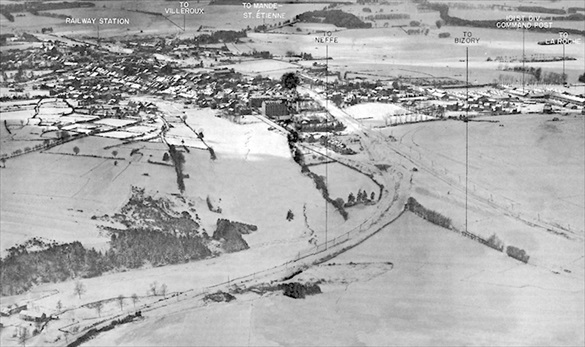 |
Above: Control of its Bastogne’s crossroads was vital to the German offensive directed at the Allies’ vital supply harbor at Antwerp, Belgium, because all seven main roads in the Ardennes Forest (five roads and one railway station are identified in this photo) converged on this small Eastern Belgium town. The German siege of Bastogne lasted from December 20 to 27, 1944, after which it was broken by elements of Gen. George S. Patton’s U.S. Third Army. Not until January 9, 1945, based on Ultra intercepts, did the Allies learn that the enemy, half-starved, lacking transport, yet struggling to push vehicles and heavy equipment in extreme cold, was abandoning the Bastogne sector, or pocket. On January 11 the German retreat was under heavy American artillery fire.
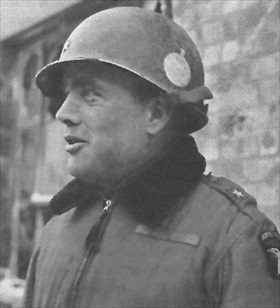 | 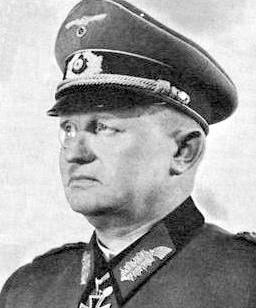 |
Above: Brig. Gen Anthony C. McAuliffe (1898–1975) (left frame), a division artillery commander thrust into role of acting commander of the 101st Airborne “Screaming Eagles” Division, famously called German Gen. Heinrich Freiherr von Luettwitz’s bluff. Luettwitz (1896–1969) (right frame), an armored corps commander who knew the capture of the Belgian crossroads town of Bastogne would be costly and time-consuming with his forces at hand, on his own initiative sent two emissaries under cover of a white flag to McAuliffe’s command center on December 22, demanding surrender of the town. Bastogne, Luettwitz alleged in his note, was surrounded by strong armored forces (his), soon to be reinforced by artillery and heavy (nonexistent) antiaircraft battalions. McAuliffe had a military, moral, and life-and-death decision to make for his besieged men and Bastogne’s civilians. His monosyllabic, all caps decision carried back to Luettwitz, “NUTS!” (equivalent to Bloedsinn in German), never did provoke crippling German punishment, though the Luftwaffe did hammer the town on December 24 and 30, the latter in a 73‑plane raid. U.S. C‑47 airdrops of medicine, ammunition, and food on December 21, 23, and 26, the latter delivery augmented by 11 Waco engineless gliders bringing medical personnel and fuel, helped sustain the defenders, outnumbered approximately 5 to 1. After dusk on December 26, a tank battalion of Gen. George S. Patton’s Third Army broke the town’s siege, opening a southern supply corridor. The corridor was so narrow “you can spit across it,” one officer remarked.
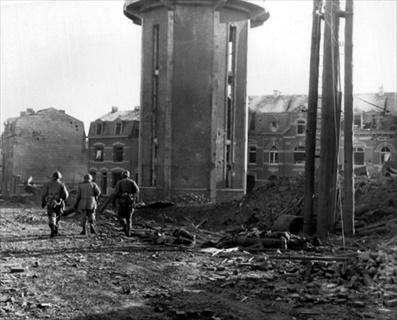 | 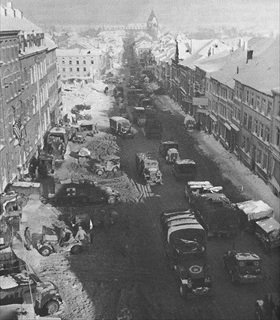 |
Left: On a rubble-filled street in Bastonge on Christmas Day, 1944, three members of the 101st Airborne Division walk past bodies of fellow soldiers killed in a German bombing raid the night before. The 101st Airborne Division received a Presidential Unit Citation for their heroic defense of Bastogne. On December 30, 1944, Patton personally awarded McAuliffe the Distinguished Service Cross, the second highest military award that can be given to a member of the U.S. Army. Three days later the Army promoted McAuliffe to major general and gave him command of the 103rd Infantry Division, which he led from January to July 1945.
![]()
Right: U.S. supply trucks and replacements for the 101st Airborne Division roll through the bomb-cratered, shell-torn streets of Bastogne following the town’s deliverance on December 27, 1944. By then the Ardennes initiative had passed from German to American hands, as both sides realized. German media abandoned headline treatment of the Ardennes Campaign to focus on developments in Nazi-occupied Greece and Hungary.
Battle of Bastogne, December 20–27, 1944
![]()

 History buffs, there is good news! The Daily Chronicles of World War II is now available as an ebook for $4.99 on Amazon.com. Containing a year’s worth of dated entries from this website, the ebook brings the story of this tumultuous era to life in a compelling, authoritative, and succinct manner. Featuring inventive navigation aids, the ebook enables readers to instantly move forward or backward by month and date to different dated entries. Simple and elegant! Click
History buffs, there is good news! The Daily Chronicles of World War II is now available as an ebook for $4.99 on Amazon.com. Containing a year’s worth of dated entries from this website, the ebook brings the story of this tumultuous era to life in a compelling, authoritative, and succinct manner. Featuring inventive navigation aids, the ebook enables readers to instantly move forward or backward by month and date to different dated entries. Simple and elegant! Click 











